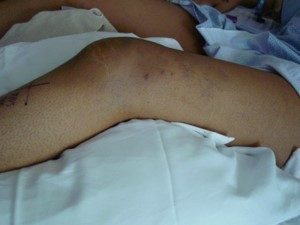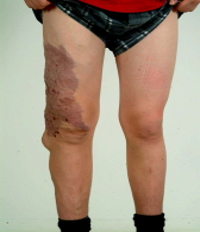Vascular Malformations
What are these?

Vascular malformations are abnormalities of blood or lymph vessels which people are born with (congenital) and which grow as the individual grows. There are many types of vascular malformations (listed below) which reflect the types of blood vessels which are involved. They may occur singly or multiply, may involve the skin or internal organs (such as the liver, lungs, or brain), or both. Although vascular malformations are usually an isolated problem, in some individuals they occur as part of a syndrome (a bunch of related problems). Some individuals may have several different kinds of vascular anomalies (for example, both a vascular malformation and a hemangioma).
Types of vascular malformations
- Capillary malformations (Port-wine stains)
- Venous malformations
- Arteriovenous malformations
- Lymphatic malformations (cystic hygromas)
- Combined malformations (such as venous-lymphatic malformations)

Syndromes involving vascular malformations
- Klippel Trenaunay (KT) Syndrome
- Parkes Weber Syndrome
- Generalized Lymphatic Anomaly
- Gorham’s (or Gorham-Stout) Syndrome
- Cowden Syndrome
How are vascular malformations diagnosed?
What happens to vascular malformations over time?
In many cases, these may not be seen or felt at birth or even during childhood. Venous, lymphatic, arteriovenous and mixed malformations typically grow as a child grows, but may grow out of proportion to the growth of a child, especially around the time of puberty. They do not go away by themselves. They may shrink or swell due to changes in position (such as prolonged standing), activity, infection, and pregnancy.
What causes vascular malformations?
Although more and more information is being discovered about· genes which can be abnormal, the cause of most vascular malformations is not known. Vascular malformations are not usually seen in more than one family member. In the case of rare syndromes. such as Hereditary Hemorrhagic Telangiectasia (HHT) or Cerebral Cavernous Malformations {CCM), vascular malformations can be inherited problems for multiple family members.
How are vascular malformations treated?
Treatment should always be done by individuals with experience in taking care of children with vascular malformations. Almost always, health care providers from multiple disciplines or expertise will be needed. Treatment may range from supportive care including compression garments which may have to be specially made, massage therapy, orthopedic and orhtotics management of limb abnormalities, physical therapy, antibiotics or antiinflammatory medicines to vascular interventional therapy (sclerotherapy!embolization therapy) and sometimes surgical resection. A number of medicines such as Sirolimus (rapamycin) are playing an increasing role in treatment. Anticoagulation (blood thinners) may be needed for evidence of intralesional clotting and to prevent clots at the time of VIR or surgical treatments. Laser therapy may be needed for overlying skin changes.
What should we look for?
- Where your child’s vascular malformation is located will help guide what you should be aware of. For example, in vascular malformations involving an arm or leg, difficulty in moving that extremity may become an issue. Your child’s doctors should give you a list of symptoms for which you should call them immediately and others which can wait until normal working hours.
- If a lesion grows unexpectedly, hurts, or if the overlying skin becomes red or swollen, immediate attention may be important. Vascular malformations can develop acute inflammation or clots within the lesion.
- If your child develops sudden difficulty breathing or shortness of breath (even without a fever) immediate attention is important. Intralesional clots have been known to lead to pulmonary embolism.